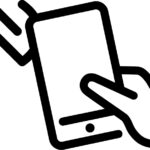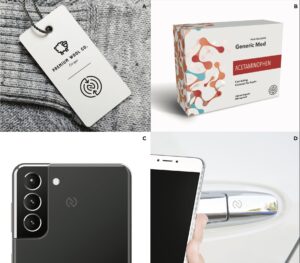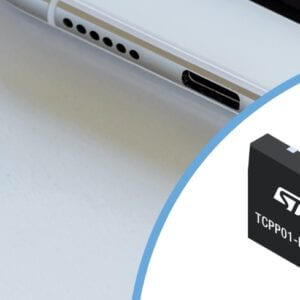To improve the accessibility of our content, please find the audio version of this blog post.
ST just updated its white paper on the NFC design considerations for an improved user experience with the latest Wayfinding Mark System and guidelines by the NFC Forum, which ensures end-users better grasp where and how to tap their phone or watch. The update is highly symbolic because it is the next chapter in the NFC adoption story. The new iconography vies to grab the collective consciousness to make contactless solutions ubiquitous. And makers are already players in this new act. Indeed, companies must now choose between icons knowing they’ll have repercussions for the lifespan of their product. Hence, let us understand the reasons behind the new Wayfinding Mark System and how to best benefit from it.
Contactless Doesn’t (Yet) Mean Frictionless
The Issues With the Present Experience
The NFC Forum, of which ST is a member, published the results of a survey in June 2021 about users’ experiences. The two most prominent issues reported by consumers were the experience taking too long and a lack of information. For instance, only 30% knew where to tap on their mobile device. Unfortunately, about 35% had difficulties during the first few tries and 20% still occasionally failed to remember where to tap. When drilling into the answers, the NFC Forum found that more than 25% had issues finding the tap point because they either had no information or the information wasn’t helpful.
The global pandemic further exacerbated the issue. Indeed, contactless payment significantly grew in popularity as people avoided touching coins, bills, and hard surfaces. Overnight, tapping a bank card or a phone became a health-saving measure, encouraging many to adopt the new feature. Yet, despite the crises, too many still aren’t always sure where to tap or that they can use their virtual wallets for other applications than for a payment. Hence, as the world is coming out of the pandemic, the NFC Forum is jumping on the opportunity to improve this situation.
The Successes of the Contactless Revolution

It is imperative to put those numbers into perspective. For nearly 90% of users, NFC transactions are successful on the first try, thus showcasing a tremendous success rate. Moreover, almost 80% of people surveyed by the NFC Forum found the interaction natural. A study published by ABI Research in 2020 found similar results, with 88% of their respondents claiming a positive experience. Even more encouraging, the analysts found that once exposed, the vast majority of users used the technology almost daily, with more than 80% storing more than one card in their mobile wallet. Put simply, most consumers have adopted NFC. The NFC Forum is now looking to reach those still struggling with real and concrete issues.
New Wayfinding Mark System, Because Contactless Can Mean Painless
Simplified

According to the survey data, the solution to the current challenges will come from a new iconography. Indeed, the NFC Forum survey showed that 35% of respondents managed to find the tapping point despite having no information because they recognized a symbol. Hence, the organization came up with a new and simplified N symbol. The minimalist version is purposefully wide to fit narrow objects like car door handles. Similarly, phone makers can place it on their products without compromising aesthetics. The wayfinding mark represents an N using two interlocking branches to symbolize the coming of two different objects, thus implying the idea of users tapping at that location.
Directional

The NFC Forum also designed two other icons built on the simplified version. The first one is called directional because it uses arrows to guide users. It is more prominent and uses concentric waves to attract consumers’ eyes while leaving the impression of a wireless interaction. In their supporting documentation, the NFC Forum sees this particular symbol on the broadest range of products. Hotels can place it on doors, shops can use it on tags, and manufacturers would put it on their packaging, to only name a few. The directional icon doesn’t allude to payment but remains neutral, thus testifying to the Forum’s desire to expand NFC technology to more use cases.
Charging

The desire to cover more applications also led to creating an icon dedicated to wireless charging. Indeed, the image is nearly identical to the simplified version but with only a symbolic thunder on top. The image must only apply to charging cases to avoid confusion, which also explains its simplicity. The absence of waves, as on the directional version, means to represent the limited but critical use case of this application. The NFC Forum knows that many still struggle to understand wireless charging. Consumers don’t always know if a device supports it and where to use it. Thanks to this dedicated iconography, the Forum hopes to make wireless charging more ubiquitous.
Instructional

Finally, the last image in the new WayFinding Mark System is an instructional version. It shows a hand bringing a phone over the simplified or directional icons. As the name implies, it spells out the interaction to even the more novice of users. The sign is the biggest of them all and will target products that don’t usually enjoy contactless interactions. With it, the NFC Forum builds on their survey results to address the demographics least familiar with the technology. The instructional version also reuses the simplified and directional icons to serve as a bridge to consumers. As people become more familiar with the technology, makers will be able to switch from instructional to the simplified or directional versions.
Better User Experience Means Better Education

The NFC Forum is making the new Wayfinding Mark System as frictionless as possible. The use of the icons isn’t tied to the certification process as the Forum wants to democratize them as soon as possible. However, this goal is only achievable if we educate product makers and the public. A study by researchers in Vienna1 shows that NFC payments suffer from “several misassumptions among the users,” leading the authors to conclude that “there is still room for improvement in NFC on usability and user experience.” Similarly, another paper published in 2019 showed visual feedback played a critical role in improving interactions with NFC payment terminals2.
Hence, democratization will imperatively demand a more excellent education of both the people making NFC-compliant products and of the public. It’s the reason why ST doesn’t simply provide devices and development tools that have helped companies bring the technology to new products, such as the first NFC-enabled fragrance. We also aim to educate partners on key aspects of the user experience, NFC touchpoints, the inner workings of the technology, how mobile devices use it, and what makes a successful application.
- Download the white paper NFC Design Considerations for an Improved User Experience
- Benefit from the ST25Connect program by optimizing NFC integration and implementation
- Explore ST’s educational content on NFC Technology
- Check out three applications that use NFC and mobile applications
- How NFC can solve connectivity challenges in smart monitoring
- Santhana Kumar, P., Bechinie, M., Tscheligi, M. (2018). NFC Payments – Gaps Between User Perception and Reality. In: Hansen, M., Kosta, E., Nai-Fovino, I., Fischer-Hübner, S. (eds) Privacy and Identity Management. The Smart Revolution. Privacy and Identity 2017. IFIP Advances in Information and Communication Technology(), vol 526. Springer, Cham. https://doi.org/10.1007/978-3-319-92925-523 ↩
- Santhana Kumar, P., Bechinie, M., Tscheligi, M. (2019). How to Improve the Interaction Design of NFC Payment Terminals?. In: Lamas, D., Loizides, F., Nacke, L., Petrie, H., Winckler, M., Zaphiris, P. (eds) Human-Computer Interaction – INTERACT 2019. INTERACT 2019. Lecture Notes in Computer Science(), vol 11747. Springer, Cham. https://doi.org/10.1007/978-3-030-29384-04 ↩




